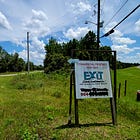This is the third and final part of a series of stories about the trial.
Lawyers for Pegasus and Reynolds Industrial Park have raised the issue of Florida law regarding zoning around airports. After all, their lawsuit against the city of Green Cove Springs and the family of Virginia Hall centers on whether apartment buildings aligned with a runway create a hazard.
Representing the Halls, Attorney Fred Franklin objected to that line of argument, however, saying against any application of Chapter 333 of Florida law was “inapplicable to the Reynolds Park Airport because, as we know, the airport is private and not public.”
At trial, conducted July 6 and 7, Circuit Judge Don Lester signaled an inclination to agree, but Lester said he was willing to hear an abbreviated version of the plaintiff’s arguments before deciding whether to disregard that testimony.
Previous Installments
(This is a bench trial, which means no jury. When the judge is the decider, there is little harm in hearing non-relevant arguments because it is presumed a judge is able filter out any kind of “noise” when reaching a decision.)
In opening remarks Barry Davidson, lawyer for Reynolds Park, acknowledged the court’s forebearance:
Davidson: I understand, Your Honor, when the fussing about Chapter 333 was made and Your Honor said, well I'm not going to strike it now and we'll see how it develops. And I also understood you said, but don't let it be a sideshow.
Lester: A trial within a trial.
Barry Holesko is CEO at Passero Associates, a St. Augustine company that helps plan design and build airports. Holesko testified about consulting work he had done to produce a report about extending the Reynolds runway from 5,000 to 7,400 feet. As it now stands the runway ends about 2,700 feet from the 14-acre parcel at issue in the trial.
Holesko testified that having 59-foot-high apartments at the end of the proposed runway would hinder certain types of landing procedures and contradict restrictions on having a place of “public assembly” that close along the landing path.
And then just from a noise and land use perspective, we believe that it would not meet Florida DOT basic standard for how close it is to the runway. And the people that would most likely be occupying those units, they're going to complain to someone. I don't know who that's going to be, whose phone is going to ring, but they would complain to someone…
The Florida DOT standard inside Chapter 333, might be in 332, I get it mixed up sometimes between the paragraphs. But it states that without a formal noise study being completed and shared with the general public, that an airport should protect incompatible land uses such as residential, at a distance equal to one half the length of the runway end on the runway and on the sides of the runway. So that area is the area of protection if you don't have a formal publicly involved noise 24 compatibility study.
Holesko also testified that even if the runway were not extended, noise would still be a problem and, to some degree, there would also exist a threat to public safety. “If there was going to be a safety incident involving an arriving or departing airplane, the extended runway standard length is the location where that's most likely to occur,” he said.
Holesko was cross-examined by Green Cove’s hired counsel, Wayne Flowers. Holesko admitted that he knew of no move to actually extend the runway and redo the airport for general aviation. He remembered, however, the estimate for what it could cost: more than $67.6 million, about $30 million of which would have come from Reynolds Park itself.
Questioned by Flowers, Holesko admitted that according to state and federal metrics for acceptable airport noise and safety, the proposed apartments are far enough away from the end of the runway to meet criteria for both.
Michael Arnold, an airport planning, noise and environmental consultant, testified as an expert witness for the defense. Arnold is senior vice president for Environmental Science Associates of Orlando. Citing Part 77 of federal regulations regarding airport zoning, Arnold said:
I analyzed the Part 77 surfaces for the (Reynolds Airpark) runway, looking at the 20-to-1 approach surface for a visual runway. Based on that—that slope and the distance between the runway and the property boundary, the Part 77 surface would be at approximately 120 feet as it crosses over the property. Given the proposed height of the buildings being 59 feet, there would be about a 70-foot or 60-foot buffer over that building to the surface itself. So it would not represent a penetration to the visual approach surface.
Under cross examination, Arnold said that state law 333 (requiring studies be undertaken to ascertain airport hazards) applies only to public-use and military airports, not private-use airports such as Reynolds Park.
Davidson: So the City of Green Cove Springs needs do nothing to protect its citizens?
Flowers: I'll object to that question. Again, it's argumentative.
Lester: That's sustained.
Lester is expected to hand down his ruling by the end of the month.





As the country grows so does/will this airport. Yes we need places for housing humans but here? So close? Does GreenCove really care about the residents to come? Seems they don’t. Why not use common sense now? Set the precedence now. Let us not look like hill billy clowns. Let us not remain the community called southern fools. Please be wise. Please think of the future community. Please think of our countries safety and loving the idea this airport remain where it is. It will also grow. Allow that to happen by making the correct decision.